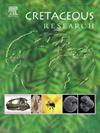西班牙上白垩纪融合石器恐龙蛋的独特组合(Poyos,中央系)
IF 1.7
3区 地球科学
Q1 GEOLOGY
引用次数: 0
摘要
本文首次详细描述了伊比利亚山脉Villalba de la Sierra组内坎帕尼亚晚期-马斯垂夏早期Poyos化石遗址(瓜达拉哈拉省)的生态学记录。该遗址发现了欧洲最南端,也可能是最古老的Fusioolithus baghensis,这是一种广泛分布的卵种,主要分布在马斯特里希特中部至最上层的沉积物中。来自Poyos的记录也允许识别来自欧洲的第二个融合石器物种,这里描述为Litosoolithus poyosi oogen。et oosp。这个卵分类群的主要特征是非常大的卵,蛋壳非常薄,与其他属于泰坦龙的蜥脚类卵分类群相比。它还表现出异常低的孔隙率,蛋壳由两种不同形状、尺寸、融合程度和有无节点的壳单元的不均匀组合组成。这个新的卵分类群也呈现出分散的纹饰,与fusuoolithus卵属典型的致密结核纹饰形成对比。对石栖石科和巨石栖石分类群球石尺寸的分析,为区分石栖石与其他物种以及区分石栖石两类球石的差异提供了统计依据。poyoos地区的poyosi石器与baghensis石器在同一地层上共存,与巨型石器或巨型石器与融合石器共存不同,在印度以外的全球化石记录中是罕见的。因此,波约斯遗址的记录为正在进行的讨论提供了有价值的数据,可以与其他类似年龄的伊比利亚-阿莫里亚地层进行比较。本文章由计算机程序翻译,如有差异,请以英文原文为准。

A unique association of fusioolithid dinosaur eggs from the Upper Cretaceous of Spain (Poyos, central system)
The oological record from the late Campanian – early Maastrichtian Poyos fossil site (Guadalajara Province) within the Villalba de la Sierra Formation at the Iberian Ranges, is described here in detail for the first time. This site yields the southernmost and possibly the oldest occurrence of Fusioolithus baghensis in Europe, a widespread oospecies mainly found in mid to uppermost Maastrichtian deposits. The record from Poyos also allows the recognition of the second fusioolithid ootaxon from Europe, herein described as Litosoolithus poyosi oogen. et oosp. nov. This ootaxon is mainly characterized by very large eggs with a exceptionally thin eggshell compared to other ootaxa attributed to titanosaur sauropods. It also exhibits an unusually low porosity, and an eggshell composed of an uneven combination of two types of shell units which differ in their shape, dimensions, fusion degree, and absence or presence of a node. This new ootaxon also presents a dispersituberculated ornamentation that contrasts with the typical compactituberculated ornamentation of the Fusioolithus oogenus. The analysis of the spherolith dimensions of Fusioolithidae and Megaloolithidae ootaxa provides statistical support for discriminating Litosoolithus poyosi from other oospecies and for recognizing the differences between its two types of spheroliths. Litosoolithus poyosi and Fusioolithus baghensis co-occur on the same stratigraphic levels in Poyos which is, unlike the co-occurrence of megaloolithids or megaloolithids with fusioolithids, a rare occurrence in the global fossil record outside India. Therefore, the record of the Poyos site provides valuable data for ongoing discussions, allowing comparison with other similarly aged Ibero-Armorican formations.
求助全文
通过发布文献求助,成功后即可免费获取论文全文。
去求助
来源期刊

Cretaceous Research
地学-地质学
CiteScore
4.10
自引率
19.00%
发文量
235
审稿时长
12 weeks
期刊介绍:
Cretaceous Research provides a forum for the rapid publication of research on all aspects of the Cretaceous Period, including its boundaries with the Jurassic and Palaeogene. Authoritative papers reporting detailed investigations of Cretaceous stratigraphy and palaeontology, studies of regional geology, and reviews of recently published books are complemented by short communications of significant new findings.
Papers submitted to Cretaceous Research should place the research in a broad context, with emphasis placed towards our better understanding of the Cretaceous, that are therefore of interest to the diverse, international readership of the journal. Full length papers that focus solely on a local theme or area will not be accepted for publication; authors of short communications are encouraged to discuss how their findings are of relevance to the Cretaceous on a broad scale.
Research Areas include:
• Regional geology
• Stratigraphy and palaeontology
• Palaeobiology
• Palaeobiogeography
• Palaeoceanography
• Palaeoclimatology
• Evolutionary Palaeoecology
• Geochronology
• Global events.
 求助内容:
求助内容: 应助结果提醒方式:
应助结果提醒方式:


